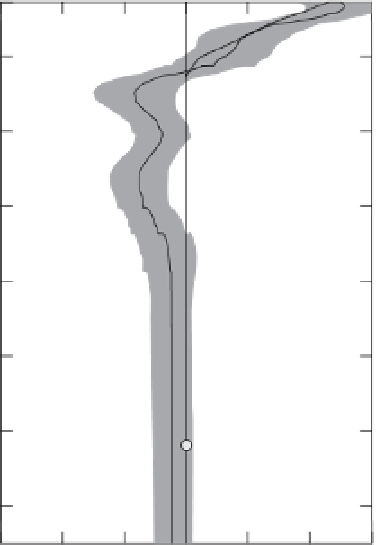Geoscience Reference
In-Depth Information
bear little information on density. While be-
ing most directly related to density, gravity pro-
vides only weak constraints, because solutions
to the gravitational inverse problem are inher-
ently non-unique. The use of free air gravity or
the geoid is further complicated by the effects of
boundary perturbations. Volumetric density het-
erogeneities by themselves affect gravity, but they
also generate topography on the Earth's surface
and internal interfaces, such as the core-mantle
boundary. The strength of the boundary pertur-
bations depends on viscosity, which is, however,
poorly constrained. Furthermore, the volumetric
and boundary perturbation effects nearly cancel at
mid-mantle depths, which precludes any robust
inference on 3D density structure.
The travel times of P and S waves - the ma-
jor source of information on the Earth's velocity
structure - are practically insensitive to density
heterogeneities. This surprisingly complete ab-
sence of information is closely related to the
scattering characteristics of velocity and density
perturbations (e.g. Wu & Aki, 1985; Tarantola,
1986). When a body wave impinges upon a ve-
locity perturbation, it generates a scattered wave
that travels along with the incident wave. The
interference with the scattered wave modifies
the shape of the original wave. This modifica-
tion is then perceived as a travel time shift that
can be used in travel time tomography to track
the causative velocity perturbation (e.g. Dahlen
et al.
, 2000). Density heterogeneities, in contrast,
generate scattered waves that travel
opposite
to
the direction of the incident wave. Therefore,
the incident and the scattered waves can never
interfere, meaning that the original pulse shape
remains unaffected. It follows that travel times of
the classical body wave phases are not influenced
by density perturbations, and that information
on density must be sought in the later parts of
seismograms. This phenomenon is illustrated in
Figure 11.3. We note that the backward scatter-
ing off density heterogeneities depends on the
parametrization of the Earth model. For instance,
choosing
ρ
together with the elastic parame-
ters
λ
and
μ
, instead of
ρ
,
v
p
and
v
s
, leads
to forward-scattering off density heterogeneities,
200
400
600
800
1000
1200
uncertainty
mean
PREM
1400
0.94
0.96
0.98
1
ξ
1.02
1.04
1.06
Fig. 11.2
Probability density function of the
spherically averaged anisotropic parameter
ξ
, modified
after (Visser
et al.
2008). Plotted is the mean model and
2 standard deviations around it. Reproduced with
permission of Elsevier.
to quantify isotropic-anisotropic trade-offs if the
parametrization is fixed a priori.
11.5 Density Tomography
Lateral variations in density are the source of
mass transport in the Earth on all scales ranging
from the upwelling of salt bodies to the sub-
duction of lithospheric plates and the ascent of
super-plumes. They are key to the resolution
of long-lasting debates including the distribu-
tion of compositional heterogeneity, the nature
of continental lithosphere, and the contribution
of mantle convection to surface tectonics. How-
ever, despite its relevance, the detailed 3D density
structure of the Earth remains largely unknown.
In contrast to seismic velocities that can be in-
ferred from travel times, most surface observables







